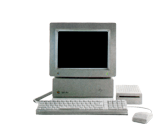News 
18/08/2018: Disk Image Updates
Qkumba's been busy with more ProDOS conversions of classic 8-bit games and I've included them, as I do all updates, on my collection of 8-bit games on a 32meg ProDOS formatted disk image.
With the release of Marinetti v3b9, which speeds things up greatly for TCP on the IIGS, I've updated my self booting Communications 32meg image with all hard drive installable comms apps that's useful for anyone with a LANceGS, Uthernet I or II, or a WiFi232. I've also updated all of Speccie's TCP apps, along with the Undo Manager, which grants apps written for the new system extensions to have multiple levels of undo. Find the link to to this disk image at the end of this blog post about BBSIng on the IIGS in the 21st century.
22/06/2018: Miscellany Menagerie
Apologies to everyone who's submitted new and interesting items to What is the Apple IIGS? and only now seeing them being included. No more delays – let's get down to it!
Qkumba's been busy as always and has most recently created ProDOS compatible versions of classic 8-bit games Thief and Track and Field, as well as an uncompressed version of Prince of Persia, which includes all original Easter Eggs (an included a text file details how to reveal them) as well as the ability to hack the game engine or saved games. Find them all in the ProDOSHackGames folder and their relevant alphabetic folder on the ![]() 8-bit Games 32meg disk image. Qkumba's also been going through the back catalogue of his ProDOS conversions and creating new versions that are compatible with the Apple II+. These newer versions will mean they're actually larger in file size, and I won't be updating the older versions on my 8-bit games collection, because they still work fine on the target platform here, the IIGS, as well as the IIe, IIc and IIc+.
8-bit Games 32meg disk image. Qkumba's also been going through the back catalogue of his ProDOS conversions and creating new versions that are compatible with the Apple II+. These newer versions will mean they're actually larger in file size, and I won't be updating the older versions on my 8-bit games collection, because they still work fine on the target platform here, the IIGS, as well as the IIe, IIc and IIc+.
Bertrand Lee, owner of the remarkable online diary rediscovering the Apple II since 2015, has let me know he has a newer version of the Harmonie printer driver collection – version 2.11b, includes 600x300 DPI support for HP DeskJet/DeskWriter plus new drivers for Apple StyleWriter (M8000), DeskJet/DeskWriter 520 & 560. There's so much to explore on Bertrand's site, it's quite a journey!
Frank Rossi wrote in to say he's found an interesting key press for the unofficial conversion of Plotting, excellently done by Leclercq Philippe, aka 'Teaser'. Pressing the 'M' key will toggle between the music tracks without having to advance further in the game. Now, the music in the IIGS version of Plotting isn't the music from the arcade version – it's from Sensei, the karate sparring game by Miami Beach Software. It's great music...but it's always sounded so wrong when playing Plotting to my ears. I've since found Amiga MODs that were ripped from that port of the game and the good news is – the instrument data for them is below 64k, making it easy to convert to SoundSmith or NinjaTracker format. However, I couldn't figure out how the existing music was included in the data for the original game – it looks like it was compressed together into a single data file, so I couldn't just swap out the existing tracks replacing them with these actual Plotting music tracks.
But I've put together an additional disk with the Plotting disk image .zip that includes the original MODs and NinjaForce's MODConvert v2. The breakdown of the MOD tracks is this:plod.d.mod - short music played at the beginning of a level, although this MOD's tempo seems to be incorrect - it's slower than it should be.
plot.f.mod - short music played after successfully completing a level (tempo seems correct)
ploting.1.mod - this music isn't present in the arcade version.
ploting.2.mod - this music isn't present in the arcade version.
ploting.3.mod - this music isn't present in the arcade version.
ploting.4.mod - this music isn't present in the arcade version.
ploting.5.mod - this is the standard music played during a level in the arcade version of Plotting. It should loop infinitly, until the level is over. When you're running out of time during a level, the music is sped up to emphasise the player needs to hurry before time runs out.
None of the music is for the arcade versions of the High Score music or Game Over music.
You can compare these MOD tracks with the original arcade soundtrack on VGMRips.
Frank's also done some amazing amount of work representing the IIGS on the Hyperspin front-end for emulators.
For anyone who's used Iomega Zip drives with a SCSI card on a IIGS and wished you could change Zip disks without having to reboot, you MAY have a solution at hand after a conversation on the Apple IIGS Enthusiasts Group on Facebook came about. Possibly having the Tulin tape drive SCSI drivers installed MAY allow you to eject Zip disk volumes without a restart. Thanks to Antoine for finding these drivers amongst his collection. If they don't help with Zip drives, well, we've now got drivers for a Tulin tape backup drive! I've also put together Floptical drivers and a CDA that probably won't work for ejecting volumes of Zip drives. Anyway, it's now all on the ![]() Hardware Apps 32meg volume.
Hardware Apps 32meg volume.
Bulletin Board Systems (BBSs) are gaining in in popularity again – it's a fun distraction from social media when we can remember the good old (more private?) days of online communication. Similar to what I discovered using the IIGS emulators KEGS/GSPort or GSPlus, you can now also access the world of BBSs via telnet with the new(ish) hardware device, the WiFi232, which you can plug into your modem port (with an DIN25 adapter) and use any terminal program that once used a modem to connect to servers. The WiFi232 interprets and converts old Hayes compatible commands so your old terminal programs are none-the-wiser about actually connecting via telnet rather than a direct connection over the phone line, modem to modem. Another alternative to accessing BBSs is using an Uthernet I or II, or the even rarer LANceGS card, in tandem with Marinetti, the TCP/IP stack for the IIGS, along with Spectrum, you can relive the good old online days. You can explore BBSs quickly on the IIGS if your have one of the hardware options above with this self booting 32meg ProDOS volume I've put together that includes every communications app imaginable: ![]() Communication Apps
Communication Apps
But where to visit? Todd Holcomb wrote in to say he has a dedicated Apple II BBS which you can enjoy – Captain's Quarters BBS. It features Apple II and IIGS downloads, thousands of text files, online games including the popular Masters of Trivia, and forums. Access it via telnet://cqbbs.ddns.net:6502.
There's also the BBS Guide. You'll find other Apple II dedicated BBSs, but also any BBS hosted by other computer platforms. I like to find the most impressive ANSI graphics based BBSs to really put Spectrum through its paces and to see the state of the art of online graphics up to the mid '90s.
26/05/2018: A Development Version Sword of Sodan is now Archived! It's playable, although bugs remain...on the IIGS...right now!!!
I was cautiously optimistic when Rich Walter posted in the Apple IIGS Enthusiasts group on Facebook that he'd found the 3.5" disks that friend Jimmy Huey had in storage for over 20 years which contained a development version of Sword of Sodan for the IIGS...that was playable. Jimmy had the disks as Discovery Software gave him the option to complete the project when programmer Scott Patterson moved on from it, but Jimmy turned it down. It had sat in limbo ever since.
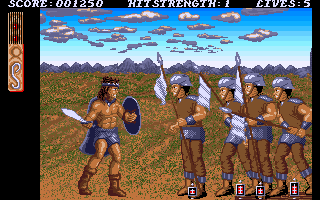
The disks were sent to John Keoni Morris, who I recommended to carefully image as working on his Applesauce device, a way of creating disk images including the copy protection itself, he's proven multiple times from testimonials across Apple II fandom that he's been able to image disks that no-one has been able to image before. The disks were sent via mail and we all held our collective breath. Would the disks still work after nearly 30 years? Would there be one sector error that prevented the game from being playable?!
Thankfully, John was able to image the disks! As bad luck would have it (at least for everyone waiting to get their hands on the disk images), I'm out of town staying with friends, and haven't been checking social media or emails...until this evening. I've since sprang into action quickly looking at the disk images on my MacBookPro, emulating the IIGS with Sweet 16.
I've only quickly checked the game in Sweet 16, and the game appears to work! I was amazed that the title screen even appeared with the same genie like affect that the Amiga version has – I really didn't expect that, as the demo we all drooled over never included it. The game does start, however, joystick emulation in Sweet 16 is...not great. Also, not having a numeric keypad, I can't play by keyboard control under emulation. But I've taken screen shots and John has said the game works...and is hard! It looks like you can choose to start from any level, which I don't believe was in the Amiga version, but it's been a while since I checked it out. It's likely this is a development feature to help debug the game.
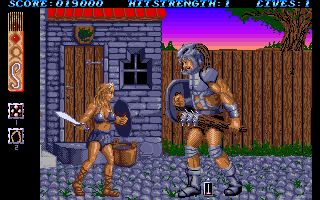
But enough reading this – you want to play it yourself, as every IIGS gamer has since 1989! Go to the Sword of Sodan archive and download the disk images there. 1meg of RAM should be enough to play with. Thanks to Antoine Vignau for an old scan of the box of the Amiga version, although if anyone has the boxed Amiga version, I'd ask if someone else could scan it, that'd be great for a better quality scan. As well as the manual, which may help.
The source code has yet to be found amongst Jimmy Huey's archives, but you can be sure Rich Walter and Jimmy will keep looking for it. More news as it comes!
UPDATE: Antoine's already begun disassembling it and has already made a single volume version so it doesn't require any disk swapping. I've included this single volume with the .zip file containing the disk images. I've also included the demo disassembly Antoine did back in 2010, for which I took screen grabs from the Amiga version under emulation to fill in for the graphics that the code was asking for, but was missing.
UPDATE 2: Matt Reichart seemed to be the first to play through the game and make notes of what works and what doesn't:
The levels are:
0 - Outside the City Gate
1 - Between the City Walls
2 - In the City Streets
3 - In the Heart of the Forest
4 - In the Land of the Dead
5 - In the Foyer of Castle Craggamoor
6 - Descend the Stairs
7 - In a Passage Deep
8 - In the Catacombs
9 - In the Foyer of Castle Craggamoor (repeat of 5)
A - At the Wizards Tower
The levels are in various states of completeness. I think 0, 1, 2, 4 and 6 are mostly complete (not a surprise that 2, 4, and 6 were seen in the demo). Level 8 is somewhat complete but is missing the large bird animal thing you have to ride and the water pit trap. Levels 3, 5, and 9 are empty but playable. Level A only has the first part of the boss and that doesn't display right. The second boss isn't even there.
Speaking of broken, there are lots of bugs and issues. I had the game ask for a garbled disk number sometimes and crash. I also had it ask for disk 7 at one point! There are random sounds that play on levels 5 and 9. The foreground tree graphics in level 3 aren't right or are missing, and of course the last boss is all glitched up.
UPDATE 3: I've played through the game quite a lot and after some practise, can quite comfortably play all the way to level 6 – Descend the Stairs. Although I've played the Mac version a bit in the past, I've got to say, playing it on the IIGS is awesome. Joystick control is very responsive and it really does feel like an arcade quality title that we all hoped for more of on the IIGS. Antoine's single disk image version makes play even more enjoyable, as with the CFFA3000, the game could only see the first two disks and the third had to be copied to a real 3.5" disk for play to continue.
I do hope we can all somehow contribute to a fuller version of the game, but I fear without the source code, or raw artwork, this will likely not happen.
30/03/2018: And now...The Secret History of Mac Gaming
I backed a Kickstarter project last year – a book entitled 'The Secret History of Mac Gaming'. I received the book about a month ago and completed reading it in the last week. It's a truly great book.
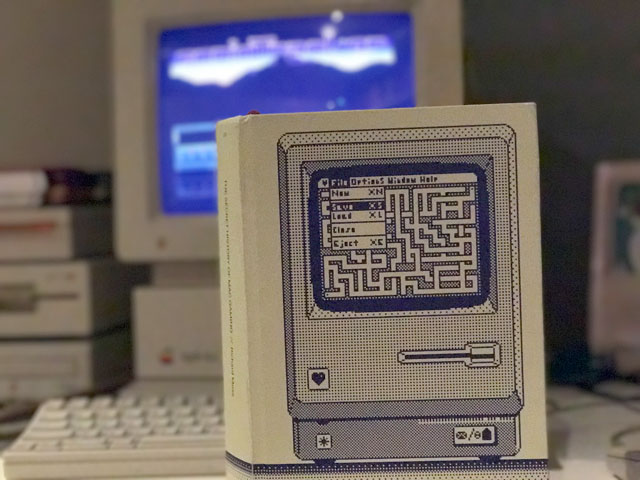
Although I grew up with an Apple IIGS, moving with the times, our family got a PowerMac 7100/AV in January 1995 and I've got to be honest and say I enjoyed gaming all over again on a fruity coloured logo stamped machine. It was a good time for Mac gaming – Lucas Arts were in full swing for their enhanced Mac game conversions (which featured better graphics than the MS-DOS originals) Mac shareware giants Ambrosia's catalogue was only widening, and Marathon 1 and 2 from Bungie software were simply a delight to play, taking advantage of the Mac in the first-person shooter realm.
The good times didn't last however, as Apple found itself in some financial turmoil in 1996. All too soon it felt like I had to become a user and evangelist just as I had with the IIGS, but it's a period of my ongoing formative years with computers and The Secret History of Mac Gaming certainly evoked a lot of good memories of those days. Possibly the darkest looking days for Apple were the most fun in hindsight, as we rallied behind the cause of computing...differently.
The book itself is almost entirely text based, which surprised me given the visual history approach I've always planned for the IIGS coffee table book (yes, I still hope to complete it, although my current thinking is it will be broken up into separate volumes now, as there's just too much content to include in a single tome). But author Richard Moss's interviews and concise prose deliver such a wonderful human side to every tale told on developing games on the Mac – stories quite like what we know on the Apple II and IIGS as well. The youthful energy, hopes and dreams of the early adopters of the Mac is palpable and I really felt great for their successes and sorrow for what would be almost inevitable failures as the Mac's fortunes as a gaming platform twisted and turned like a roller coaster.
Relevant to the Apple II and IIGS, there are interviews with very notable people who developed for both platforms. Brian Greenstone, founder of Pangea Software is given a whole chapter and his past as a games developer on the IIGS is duely acknowledged. If you ever wondered what happened to him, his tale of struggling Mac game developer paid off when his Nanosaur game became bundled with the then new iMac in 1998 and then stratospherically rose again to undreamt of heights as a sole developer when Pangea's games were amongst the initial offerings on the App Store when it first launched in 2008 with the introduction of the iPhone 3G.
The story of Crystal Quest, the first colour Mac game is fully traced, as are the origins of Shufflepuck Cafe. Rebecca Heineman's porting work on a slew of Mac games conversions is well covered (including games Wolfenstein 3D and Out of This World, which helped in getting IIGS versions made) and the stories of how the ICOM series of point and click adventure games (Deja Vu I and II, Uninvited, Shadowgate) and seminal Mac favourite Dark Castle were made, all games that got IIGS colour conversions, are great reads as well. Even Glenda Adams, who was the champion of Mac gamers everywhere for her ports of blockbluster PC games, is worth mentioning because it was only recently discovered that she was an Apple II geek as well, although in her earlier high school days, cracking games rather than writing them. And I was delighted to find out that Jason Jones, still the creative director at Bungie after Marathon, Myth, Halo and Destiny series, initially started his first game, Minotaur, on the Apple II (although it was completed on the Mac).
I tip my hat to fellow Melbournite Richard Moss for delivering a wonderful historical account using almost only the readable word to convey so much. The design is minimal and doesn't take away from the engrossing text. Details of where to buy the book online and everything else can be found here. Also, be sure to give his podcasts Ludophilia and The Life and Times of Video Games a listen.
30/01/2018: Clip Copy Plus Finder Extra Released
Clip Copy Plus is a new Finder Extra that could just make your day!
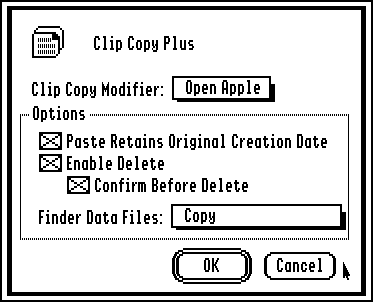
Ever wished the System 6 Finder would let you use copy, cut and paste for file management in the same way that Windows has allowed for years, and that Apple finally caught onto with Mac OS X around 15 years ago? Well now you can! Chris Vavruksa has dusted off his archives of in progress development from 20 years ago and has completed this Finder Extra. You can download either a SHK or 2image archive, graciously hosted by Ewen Wannop over on his site or you grab it from the 'Finder.Extras' folder of What is the Apple IIGS' collection of ![]() System Add-ons.
System Add-ons.
22/01/2018: Christmas Gifts #2 8-bit 3.5" Disk Based Educational Software Additions
We've got some new additions for 8-bit educational software on 3.5" disk!
Antoine has found several more titles - Little Shopper's Kit and Time Liner, both by Tom Snyder Productions, The Balance in Nature by Focus Media (complete with documentation) and DLM Maths Fluency – Division Facts by DLM.
I was lucky enough to buy a boxed copy of The Playroom locally in Melbourne, so I've added a box scan for that. I also found the front of the manual for Reading & Writing with Boars was the box, so added a scan for that title as well.
21/01/2018: Patentedly Tardy Christmas Presents Not Only Late, But Fewer As Well! Happy New Year!
Merry Christmas!...for last year. Where does the time go? My family, so time well spent, but it just goes so fast.
The first of my annual late Christmas gifts (now more tuncated than previous years) started with my love of arcade games which recently lead me to www.vgmrips.net, but much to my surprise, there are also Apple IIGS game music rips as well! I've created a dedicated playlist using my account on the site that anyone can listen from within a modern web browser.
At time of writing, these game soundtracks have been ripped from the IIGS:
King's Quest I, II & III
The Black Cauldron
Space Quest II
Arkanoid I & II
Tetris
From what I've been able to gather, the music is ripped while being emulated within MAME and whatever support it has for ‘recording' audio.
The resulting files are not straight audio recordings like mp3s, but rather the sequencing and instrument data has been collected and is emulated on the fly for playback. Alternatively, you can export tracks from vgmrips.net as mp3s for more ‘traditional' music players.
You can play the resulting vmg tracks from the site of course, but there are also desktop and smart phone players as well.
I hope other IIGS audiophiles will use this emulation technology to record IIGS game soundtracks and other notable music and submit to vgmrips.net. It's inspiring to see so much great music recorded in this way for so many gaming and computer platforms out there.
On relatively the same subject, Dagen Brock recently discovered a SoundSmith player written in Javascript that can also allow IIGS music to be heard via a modern web browser (Chrome and Firefox Quantum are up for the task, but Safari sadly doesn't want to play ball).
The demo includes rips of music from the FTA demos Modulae, The Xmas Demo and a couple of other tracks. As a bonus, there's also an ‘FTA Tracker'. Before the FTA moved onto SoundSmith as their tracker of choice, they were developing one themselves that they used for the Nucleus demo and the Photonix I & II copy utilities.
There's lots of documentation about the project and the source is all available on github.
As part of my annual late patented Christmas gifts, it's time again to provide easy access to old news. These links will take you back, year by year, into past announcements and inclusions of content on What is the Apple IIGS? Happy exploring!
